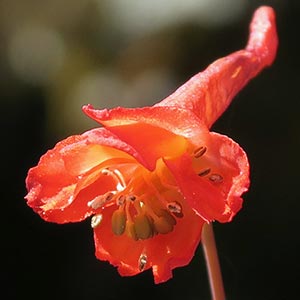Delphinium nudicaule
Delphinium andersonii
canyon delphinium, canyon larkspur, orange larkspur, red larkspur, red or orange larkspur, scarlet larkspur
Anderson larkspur, Anderson's larkspur, desert larkspur
(15-)20-50(-125) cm;
base reddish, glabrous.
(20-)30-60(-90) cm;
base reddish, glabrous.
blade round to pentagonal, 2-6 × 3-10 cm; ultimate lobes 3-12, width 5-40 mm (basal), 2-20 mm (cauline).
blade round, 1.5-4 × 2-6 cm, nearly glabrous; ultimate lobes 5-30, width 2-8 mm (basal), 1-4 mm (cauline);
lobe width of proximal leaves less than 4 mm.
5-20(-69)-flowered;
pedicel (1.5-)2-6(-8) cm, glabrous to glandular-pubescent;
bracteoles 14-20(-30) mm from flowers, green to red, linear, 2-4(-9) mm, glabrous to puberulent.
10-25-flowered, cylindric;
pedicel sigmoid (proximally spreading, distally ascending), 1-4(-6.8) cm, glabrous to puberulent;
bracteoles 2-6(-8) mm from flowers, green, linear, 4-6(-11) mm, ± puberulent.
sepals scarlet to reddish orange, rarely dull yellow, glabrous, lateral sepals forward-pointing to form pseudotube, (6-)8-13(-16) × 3-6 mm, spurs straight, slightly ascending, (12-)18-27(-34) mm;
lower petal blades elevated, exposing stamens, 2-3 mm, clefts 0.5-1 mm;
hairs sparse, evenly dispersed, yellow.
sepals dark blue, nearly glabrous, lateral sepals spreading to reflexed, 9-16 × 3-7 mm, spurs horizontal to slightly ascending, often decurved apically, 12-18 mm;
lower petal blades elevated, ± exposing stamens, 4-8 mm, clefts 1-4 mm;
hairs centered, mostly between claw and base of cleft, white.
13-26 mm, 3.5-4.5 times longer than wide, glabrous.
17-32 mm, 4-5.5 times longer than wide, glabrous.
unwinged or sometimes slightly wing-margined;
seed coat cells with surfaces smooth.
seed coat cells ± brick-shaped, cell margins ± undulate, surfaces smooth.
= 16.
= 16.
Delphinium nudicaule
Delphinium andersonii
Delphinium nudicaule hybridizes with most other taxa of Delphinium that it encounters. Apparent hybrids involving D. nudicaule, and seen by the author (either afield or as specimens), include D. andersonii, D. antoninum, D. decorum, D. luteum, D. nuttallianum, D. patens, and D. trolliifolium. In addition, garden-grown plants have been hybridized with D. cardinale, D. elatum, D. menziesii, D. parishii, D. penardii, D. tatsienense Franchet, D. triste Fischer ex de Candolle, and D. uliginosum; D. nudicaule does not naturally occur with these species. Delphinium nudicaule is one of the earliest larkspurs to flower in any given locality. Douglas's type collection of D. nudicaule represents plants (synonyms D. sarcophyllum Hooker & Arnott and D. peltatum Hooker, an invalid name) grown under very moist conditions, probably quite near the ocean. The type specimen of D. armeniacum A. Heller represents plants grown under unusually dry conditions.
The Mendocino Indians consider Delphinium nudicaule a narcotic (D. E. Moerman 1986).
(Discussion copyrighted by Flora of North America; reprinted with permission.)
In much of its range Delphinium andersonii hybridizes occasionally with members of the D. nuttallianum complex and apparently with D. parishii in at least one site in California. These three taxa, with D. scaposum, form an interesting group in that they appear to be ecological replacements for one another, with D. parishii occupying arid, hot deserts to the south and southwest, D. andersonii growing in cooler, higher latitude and altitude deserts farther north, D. scaposum in cool deserts farther east, and D. nuttallianum at higher elevations in much of the geographic range of the other three species. Delphinium andersonii is often mistaken for D. nuttallianum. Most individuals of D. andersonii (roots much larger and more fibrous; stems solidly attached to roots; fruits long, narrow, erect; inflorescences usually longer and narrower at base; and pedicel sigmoid) can easily be distinguished from D. nuttallianum (roots smaller and not fibrous; stems tenuously attached to roots; fruits shorter, proportionally thicker, spreading; inflorescences relatively shorter and wider at base; and pedicel nearly straight).
Although roots of Delphinium andersonii are quite similar to those of D. antoninum, the two taxa may be readily distinguished by most features that separate D. nuttallianum from D. andersonii. The name Delphinium menziesii was misapplied to D. andersonii by S. Watson.
(Discussion copyrighted by Flora of North America; reprinted with permission.)


